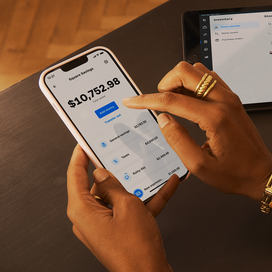Table of contents
Square cannot provide advice on tax issues. This article is for educational purposes and does not constitute legal or tax advice. For specific advice applicable to your business, please contact a professional.
In recent years consumers have shopped increasingly online, creating new opportunities for fraudst to exploit. According to Chargebacks911’s 2021 State of Chargebacks report, the majority of merchants surveyed reported an increase in chargebacks between 2018 and 2021. These same merchants approximated an average increase of 21% in criminal fraud specifically. Despite this increase in fraud, payment technology has become increasingly secure with the adoption of EMV transactions.
Businesses of all kinds face chargebacks or payment disputes when customers disagree or question the validity of their purchase. There are a few preventative measures that retailers can take so that they are prepared in the event of a fraudulent or a non-fraudulent transaction that results in a dispute.
Why Preventing Chargebacks Is Important
While it is impossible to mitigate all risk, there are preventive measures you can take as a business owner to try and prevent possible chargebacks. Chargebacks can come with unexpected costs, ranging from costs associated with acquiring that customer to operational costs processing to shipping the order, and more.
According to a recent study by Juniper Research, merchants stand to lose $260 billion between 2021 and 2025. Accounting for over 47% of fraud losses in 2021, remote physical goods purchases were the leading cause of online payment fraud.
Ways to prevent fraudulent transactions
Fraudulent Transactions
Typically in the case of a chargeback, the customer will ask for a payment to be reversed. If you use Square or another payment processor, they will be notified and reach out to you, asking whether you’d like to challenge the dispute or issue a refund. While 120 days is the average time frame to file a chargeback, Visa, Mastercard, and American Express all have their own time limits. Follow up with your respective card network to check on the deadline. If you are a Square seller, the Square Secure team will be on hand to help. Here are a few ways you can protect your business against fraudulent transactions:
- Keep a record of purchases. Having customer information such as an email, a name, and an address for an order can help you make sure the package was delivered to the right place and to the right individual. This information will also be helpful if a card was stolen and used without the knowledge of its owner. For example, if you need to respond to a dispute, you will need to share information such as proof of delivery or signed invoices. It is good practice to ensure incorrect sales receipts are voided so each transaction is processed once.
- Invest in customer service. Whether you hire staff or use customer engagement tools, there are ways to stay in touch with customers. Customer engagement tools such as private messaging, customer insights for new and returning customers, or a customer directory can help you manage communications and keep track of potentially critical information.
- Consider risk management software. There are a range of software available to businesses looking to prevent fraud more proactively. These software can monitor payments and identify unusual or fraudulent patterns. If you are a Square seller, Square Risk Manager is a tool that gives you insights into fraudulent payment patterns.
- Offer delivery confirmation. There are several ways you can show confirmation of delivery in the event of a dispute. By requiring a customer signature upon delivery, by requesting the delivery service to take a picture of the delivery, or by using a delivery tracking software that can update both the business and the customer on where the package is can show that you delivered an order to the correct address by an agreed-upon delivery date and to the intended recipient.
Using tools to mitigate criminal fraud can help automate some of the verifications you and your staff typically take on. These tasks can include making a fraud blacklist of known bad actors, CVV verification for credit cards, and address verification, to name a few.
Merchant Errors and Non-Fraudulent Transactions
Sometimes a legitimate customer will chargeback in lieu of contacting a business directly over a purchase they have made. According to a Javelin Strategy & Research study, merchants estimated about 34% of chargebacks they experienced were, in fact, “friendly fraud.” Unlike true fraud, friendly fraud is fraud that may be done somewhat unintentionally. This can happen for a number of reasons: Perhaps the customer felt the item was lost or stolen; a family member made a purchase on their behalf; they did not qualify for a refund; they forgot they made the purchase; or they didn’t recognize the business name on their bank statement. Here are a few ways you can protect your business against non-fraudulent transactions:
- Communicate delivery times. When customers are unsure whether a package is still on the way to them, they may worry it is not coming or forget they ordered it when it does arrive. If your products are made to order, communicate in advance that there may be a wait before the item arrives. In addition to this, consider letting a customer know when an order is being prepared or filled and when it has shipped. This will give them a better expectation of when it will arrive.
- Clearly mark out-of-stock items. Help manage customer expectations if a popular item is out of stock. Offer to notify them when it is in stock or clearly mark how long the wait might be. If customers check out a preorder or out-of-stock item that takes longer to ship, they may expect it to arrive sooner than it does. Consider using an inventory management software to keep track of items so you can manage supply and demand better.
- Set clear expectations for refunds or returns. A customer might chargeback if they don’t realize an item is a final sale or understand how to return the purchased item. Include information about your refund and return policy where possible in emails, on sales receipts, online, and in-store.
- Check your billing descriptors. Make a purchase more easily identifiable by customizing your business’s name on receipts, invoices, and your customers’ bank statements. If the customer does not recognize a business name on their statement, they may mistakenly think the purchase was fraudulent and chargeback. For example, rather than using your name, such as “Jane Rogers,” as the business name, you might choose “Hairstylist — Jane Rogers” to describe your business service and name.
Other Chargeback Prevention Best Practices
Your options are more limited in actions you can take once a customer initiates a chargeback. One way to minimize frequency of friendly fraud or non-fraudulent chargebacks is to communicate with your customers. Here are a few best practices to consider that may help mitigate chargebacks for retailers:
- Consider using tools: If you are using software to enable and track sales for your business, keep an eye on out-of-the-ordinary purchases, such as an uncharacteristically large order, or an order with different billing and shipping addresses. Having a record of sales can also help verify that someone did indeed place an order with your business if they call to make a return or request a refund. Additionally, many payments processors will offer anti-fraud features to help combat fraud or help screen for instances of fraudulent activity.
- Clear marketing tactics: One way to prevent chargebacks is to clearly mark your store’s policies. By clearly marking how your returns and refunds work, your customers will know the best way to engage with your business rather than falsely assuming that making a chargeback is their only path to resolution for an unwanted or delayed item.
- Prioritize customer service: From delayed shipments to out-of-stock items, customers might feel frustrated and confused when they do not know where their order is. If frustrated customers have trouble understanding your store’s policies, having customer service in place is a good way to communicate with them quickly and clearly.
- Delay billing: Think about delaying billing to customers. Often a business will bill a customer before an order has shipped. By billing once an item has shipped, you also have an opportunity to let your customer know if an item ends up being out of stock before shipping and billing for it.
In the event of a chargeback, Square sellers will be notified of any disputes for transactions. They can find more information about a dispute through their Disputes Dashboard or in the Square Point of Sale app, under Reports. If your business processes payments through Square, dispute management is included in your fee. This gives you access to account protection tools, such as Two-Step Verification and end-to-end encrypted card-present payments. Square software is PCI compliant, so you do not need to pay extra for your data security.
In addition to some of the preventative measures above, there are a few red flags that might jump out at you when customers place an order. Verify whether the customer has used a real email address, has placed several orders to one address under different cards, or has mismatched billing and shipping addresses. While many of those instances can be safe transactions, looking for anything out of the ordinary can help you catch a potentially fraudulent transaction before it happens.
![]()











